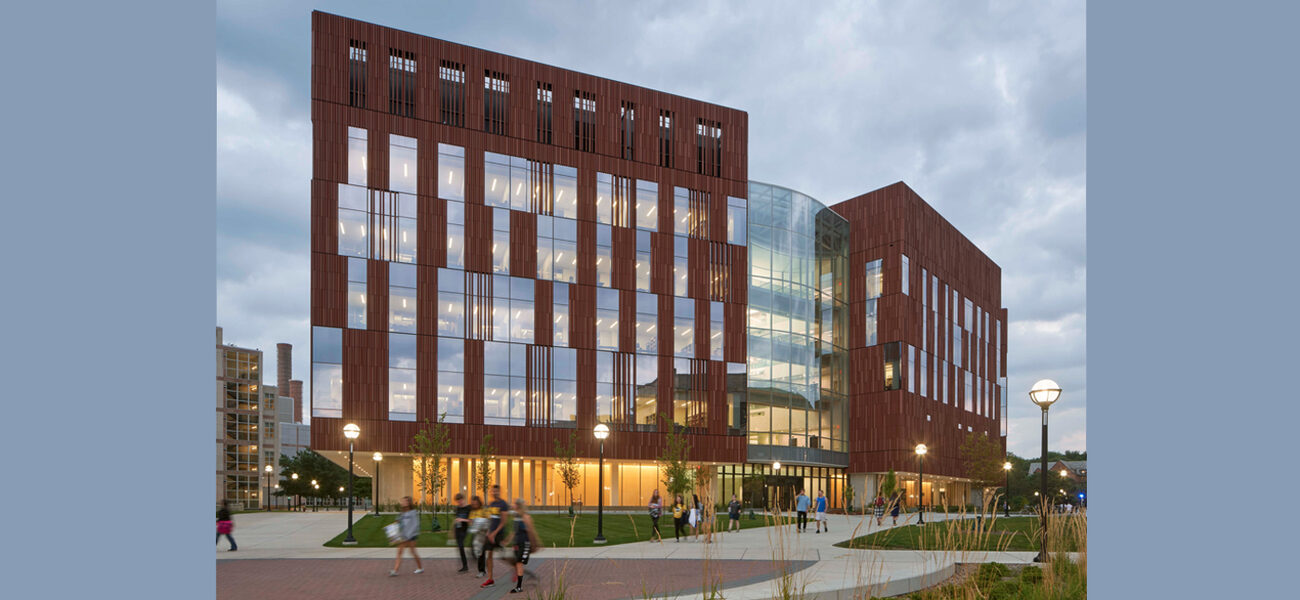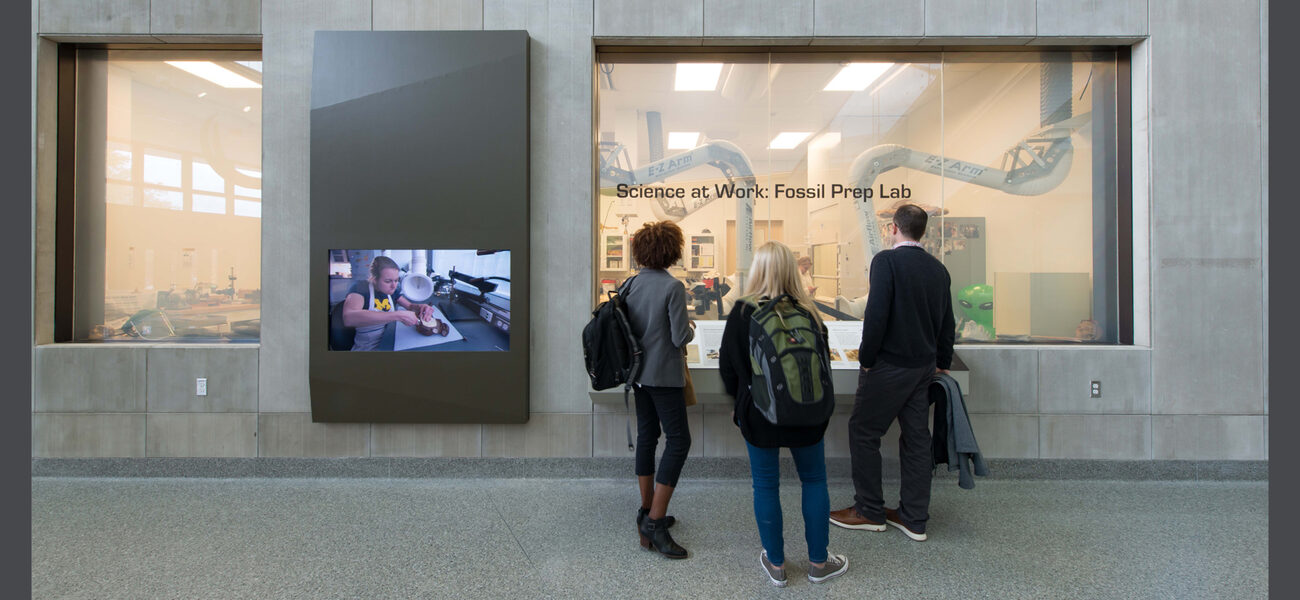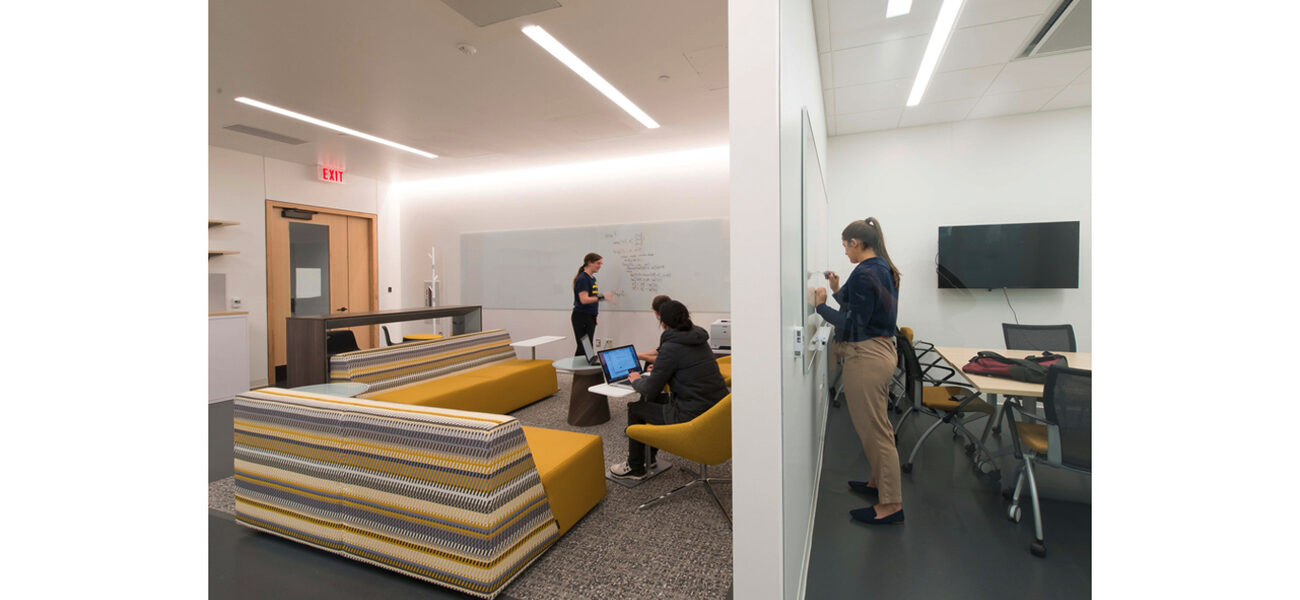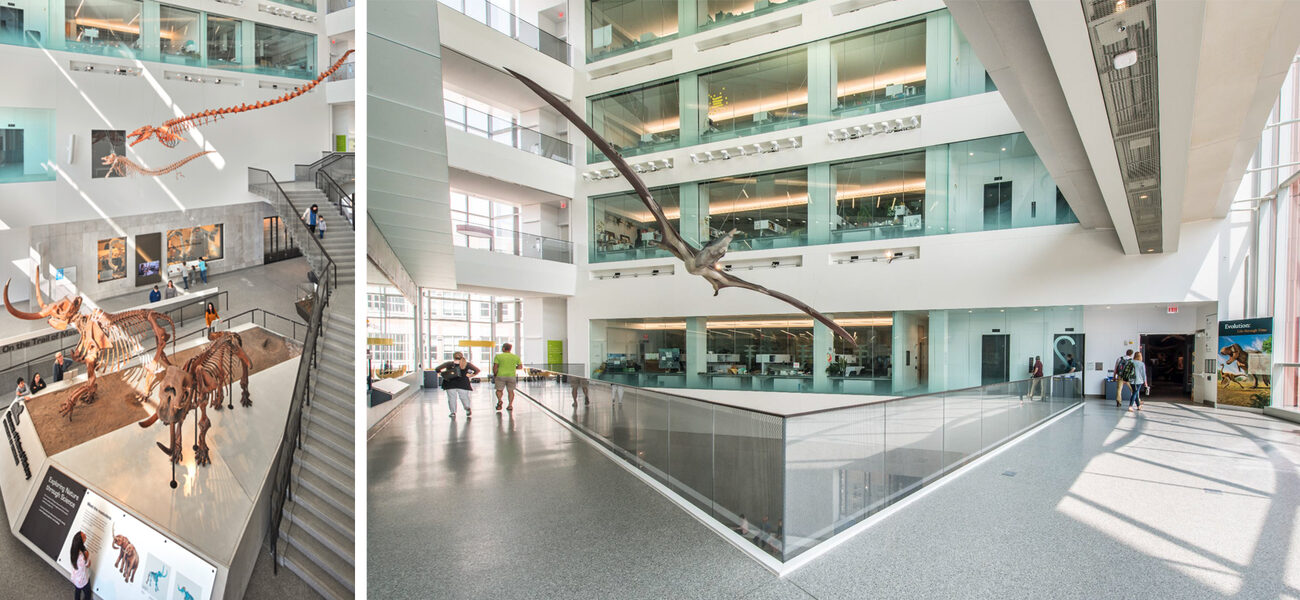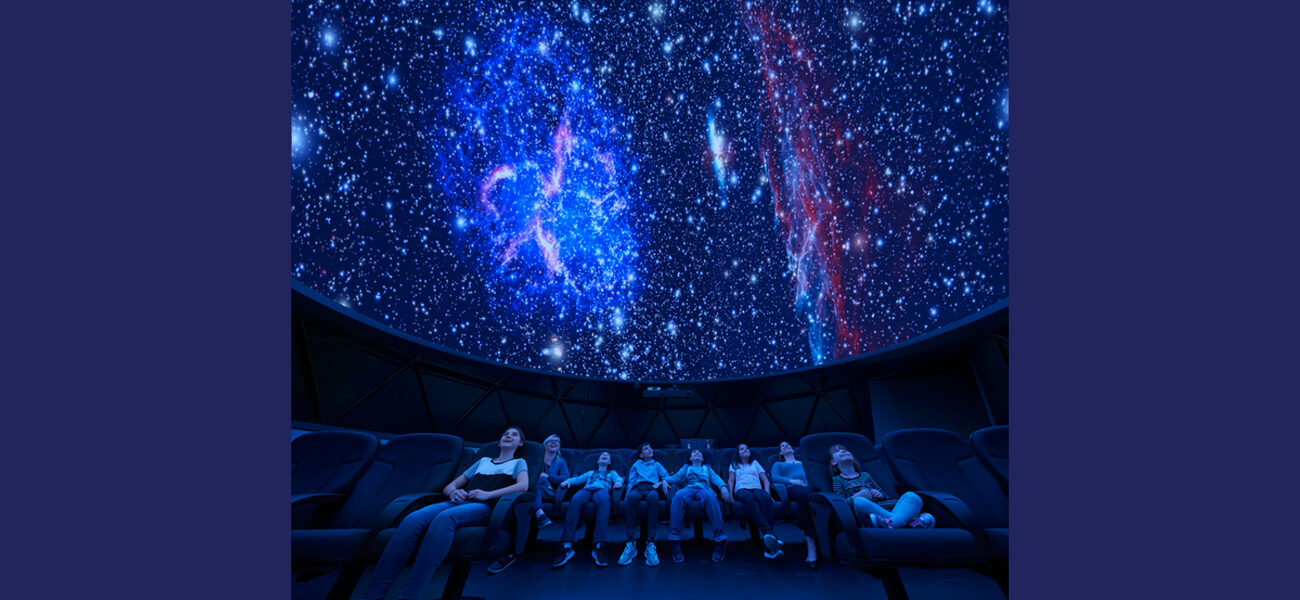The University of Michigan has transformed the way science is conducted and communicated by integrating the Museum of Natural History into its uniquely designed $261 million Biological Sciences Building (BSB). The 312,000-sf building opened for classes in 2018, and the museum opened a year later, facilitating connections between university researchers and the community. More than 200,000 members of the public visited the museum within the first year, underscoring the university’s belief that science is a social, not merely transactional, interaction.
“The biggest challenge of having a public museum in a research and education building is maintaining a safe and secure environment for all,” says Susan Monroe, capital projects manager for the university’s College of Literature, Science, and the Arts (LSA). “The architects carefully planned the integration of the museum with the research zones of the building so that select labs, such as paleo prep and biodiversity, are visible to and interactive with the public. Communication with these select laboratories is through an intercom system.”
Research is conducted in lab areas that are accessible only to principal investigators (PIs) and their graduate students via an access control system. Researchers, students, and the public can interact on the ground floor of the atrium and in the café, but the research floors and faculty offices are accessible only by using key cards on certain elevators.
Achieving research goals is a top priority, especially since the university is ranked number one among U.S. public universities for research volume, with a research portfolio of $1.6 billion. Being able to engage the community in the advancement of the research and science is part of the university’s overarching goal to create a new platform for discovery that enables interaction among science departments and researchers. Open labs, shared core facilities, and adjacency to other science and medical buildings facilitate collaboration.
The BSB, part of the College of LSA, brings together the Department of Molecular, Cellular, and Developmental Biology and the Department of Ecology and Evolutionary Biology. In addition to the Museum of Natural History, which was relocated from its former home in another building, the BSB also includes the teaching collections for the museums of zoology and paleontology.
Planning and Programming
The BSB is located at the geographical center of the Ann Arbor campus along a prominent circulation path that connects the Diag – the heart of the main campus – to the medical campus to the north. The location is at the crux of the life sciences hub, a student residential area, and the main axis through campus.
“The building was sited to take advantage of existing core research facilities and a full-service loading dock at the Life Sciences Institute, which was recently renamed the Mary Sue Coleman Hall (MSCH), to the north,” says Monroe. “This physical connection occurs on the lower level of the BSB. With a recently completed renovation of the School of Dentistry to the west, there is also a connection on the lower level that offers researchers a secure path to core research facilities in both the BSB and the MSCH.”
With input from faculty members about their current and desired future collaborations, social network mapping software was used to organize the building’s research departments based on adjacencies driven by data.
“The analysis identified the groupings of faculty most likely to collaborate on future pursuits,” says David Johnson, higher education design strategist at SmithGroup. “These affinities became the basis for the organization and space planning, with the goal of locating faculty near potential disciplinary and cross-disciplinary collaborators. We reinforced those adjacencies by creating three distinct research neighborhoods.”
Next, space allocation was analyzed with the understanding that the researchers were accustomed to working in large enclosed labs in older buildings. The BSB reduced the space allocation per PI by as much as 30 percent in order to bring many disciplines together and to allow for more open lab and shared core space. The design was modeled for more than 80 PIs, and there are currently about 65 in the building.
“The initial issue raised by faculty wasn’t area, but co-location into larger, open neighborhoods accommodating several PIs,” says Johnson. “This was managed by touring faculty through existing open labs, hosting focus groups to allow researchers to express their views, and holding town hall presentations to the full research community. Endorsement of open labs by peer faculty was the most important factor in the adoption of the open model for the BSB.”
That analysis resulted in the following space distribution (in nsf):
- Lab support, 38,500
- Open wet labs, 36,000
- Museum, 29,500
- Departmental offices/support, 19,400
- Cores, 16,500
- PI offices, 15,000
- Interaction and collaboration, 12,000
- Classrooms, 8,800
- Collections, 4,500
- Dry/computational labs, 3,750
- Building support, 3,500
- Undesignated storage, 2,000
Lab planning strategies also meant creating new standards for bench space use, with 900-1,000 nsf for less equipment-intensive disciplines, and up to 1,200 nsf for users with more analytical equipment. The allocations exclude access to linear equipment rooms and core facilities, including plant growth, and macro- and micro-imaging.
Science themes are organized into 21 neighborhoods, including wet labs, dry labs, and computational labs.
Building Features
The BSB, which showcases science in action, has open and interactive spaces, collaboration areas, visible labs, and shared facilities. It consists of three towers connected by two five-story atriums. Two towers have a below-grade level, but the easternmost one has access from the street, since the topography of the site descends from west to east. Each tower has five above-grade floors and a penthouse on the sixth level for mechanical equipment.
The third, fourth, and fifth floors in each tower feature research lab neighborhoods, including open benches, graduate student desk space outside the labs, shared lab support spaces, and a shared linear equipment room along the north edge of the building. There are a total of 84 labs in the BSB.
Four classrooms are included: a 160-seat team-based active learning classroom; two specimen-based classrooms that seat 30 people; and the Museum of Natural History’s planetarium and digital dome theater, which can be used as a classroom or for lectures and other events.
Other highlights include state-of-the-art core facilities that cover the full range of biological investigation, including plant growth rooms, plant growth chambers, and a sophisticated microscopy core.
“The building is designed around the idea of working in a transparent environment, being connected through science to a broader community, and being available in some ways to the community,” says Johnson. “We know science is not a closed undertaking, but it is social between the scientists, and also social within the larger context of what we do.”
Integrating the Museum of Natural History
The museum is embedded in the BSB, winding its way through the building and allowing the public to view the displays and some of the work taking place in the visible research labs.
“To create the modern museum experience, we want to showcase current and past research at the university by weaving the museum with the research areas,” says Monroe. “We hope that young people can see themselves working in situations like these. They can look into a lab and see what researchers and students are doing. We want to communicate that science is for everyone.”
A unique aspect of the museum is the Science Communication Fellows program, where faculty, post-doctorate students, and graduate students can learn how to conduct presentations, do public speaking, and compose presentations. To date, the museum has trained 286 participants from 43 university departments.
The 160-seat active learning classroom is used for instruction, informal learning, and faculty workshops. Museum research stations sprinkled throughout the museum display the research of a particular lab or individual. These displays will eventually be located beyond the BSB in other university buildings to increase the reach of the scientific community. The lobby of the museum has displays that feature the work of undergraduate and graduate students from a variety of disciplines, and a science forum sitting area where visitors can watch a video about natural science.
One of the most interesting features of the museum is the planetarium, more commonly called the digital dome theater. While much of the programming involves astronomy, it is also used for other natural science immersive experiences, such as exploring coral reefs or the inside of a cell.
The two specimen-based classrooms in the BSB are located across from the team-based learning room. The rooms are connected to a collection storage area that houses zoology and paleontology specimens that can be used in the classrooms.
Since the museum is now communicating science to a greater population, it is also playing an instrumental role in helping the university obtain increased grant funding. Since 2005, the museum has received over $35 million in National Science Foundation project awards, and nearly 70 percent of the funds were awarded between 2016 and 2021.
Unique Building Architecture
The exterior of the BSB presents an extraordinary appearance with a rainscreen façade made of terracotta baguettes to form the building envelope. A total of 38,500 terracotta strips are organized in alternating orientations over the span of the entire exterior. The different orientations of the strips, imported from Germany, capture light differently throughout the day. A curved glass curtainwall connects the towers and floods the building with natural light.
The atria allow visitors to look up when they enter the building and see science occurring behind the glazed openings in the research towers.
“Bringing daylight into the atria is important because it provides plenty of natural light deep into both the museum space and the research spaces,” says Lois Mate, associate principal at Ennead Architects LLP. “We did illuminance studies to determine how much daylight could penetrate into the lab zones, and determined it could help us reduce dependence on artificial light.”
Placement of the labs is important to ensure they receive sufficient natural light. Workstations are located outside the labs, so students can eat and drink but still see into the lab through the glass doors. Computational suites and living rooms provide comfortable places for students and faculty to socialize and work. The location of every component of the building was carefully considered to maximize collaboration, connectivity, natural light, and energy efficiency.
“Part of the goal was to reduce the energy use intensity (EUI) below the baseline that is standard for this building typology,” says Mate. “After everything was certified, we were able to meet an EUI of 109, which is incredible in a lab building.”
The BSB achieved efficiency with enhanced ventilation and MEP systems, stormwater management, a chilled beam system, smart light sensors, a water conservation system, sustainable irrigation, and the use of highly sustainable building materials.
The building exceeded standards by meeting the American Institute of Architect’s efficiency targets to achieve net zero emissions by 2030, and has been certified LEED gold. The ventilation and energy recovery resulted in energy savings of more than 30 percent. The MEP is designed for the entire lab neighborhoods rather than individual spaces, providing future flexibility. Labs with lower occupancy densities than non-lab spaces receive a mix of recycled and outside air.
Extensive planning, creative design, and unique construction were necessary to create a building intended to inspire, create, and display scientific discoveries. Blurring the conventional boundaries between research and the public realm accelerates that discovery.
By Tracy Carbasho
